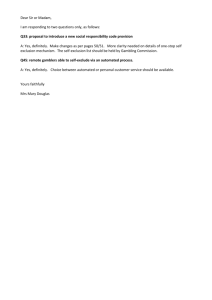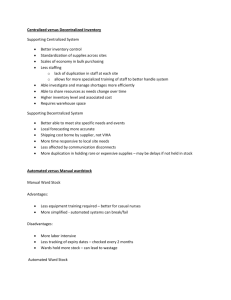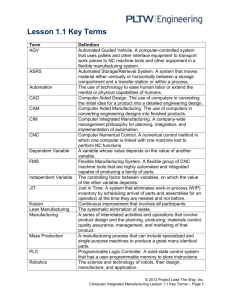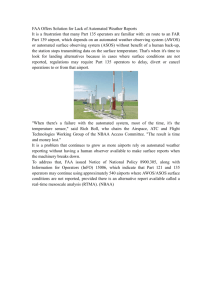From data to information and ... – The story of the ...
advertisement
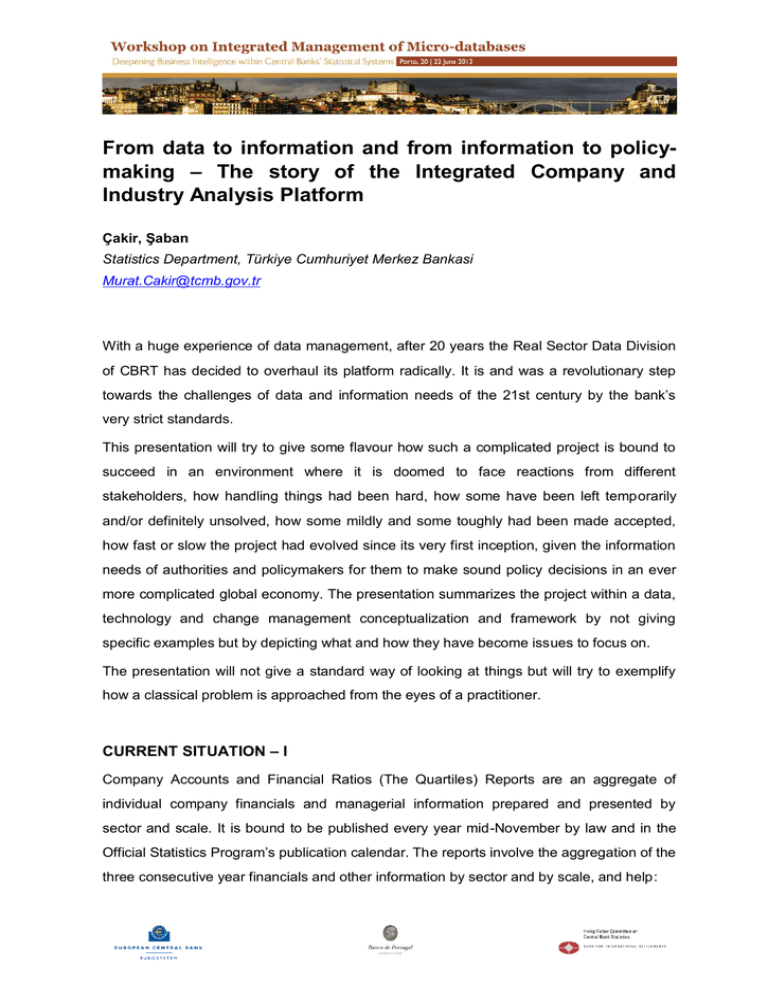
From data to information and from information to policymaking – The story of the Integrated Company and Industry Analysis Platform Çakir, Şaban Statistics Department, Türkiye Cumhuriyet Merkez Bankasi Murat.Cakir@tcmb.gov.tr With a huge experience of data management, after 20 years the Real Sector Data Division of CBRT has decided to overhaul its platform radically. It is and was a revolutionary step towards the challenges of data and information needs of the 21st century by the bank’s very strict standards. This presentation will try to give some flavour how such a complicated project is bound to succeed in an environment where it is doomed to face reactions from different stakeholders, how handling things had been hard, how some have been left temporarily and/or definitely unsolved, how some mildly and some toughly had been made accepted, how fast or slow the project had evolved since its very first inception, given the information needs of authorities and policymakers for them to make sound policy decisions in an ever more complicated global economy. The presentation summarizes the project within a data, technology and change management conceptualization and framework by not giving specific examples but by depicting what and how they have become issues to focus on. The presentation will not give a standard way of looking at things but will try to exemplify how a classical problem is approached from the eyes of a practitioner. CURRENT SITUATION – I Company Accounts and Financial Ratios (The Quartiles) Reports are an aggregate of individual company financials and managerial information prepared and presented by sector and scale. It is bound to be published every year mid-November by law and in the Official Statistics Program’s publication calendar. The reports involve the aggregation of the three consecutive year financials and other information by sector and by scale, and help: − Policymakers in assessing medium and long term policy decisions on different sectors and scale groups as well as shaping and taking their decisions about / on structural economic policies, − Bankers in their credit granting decisions by providing them with sector and scale level financial statement and structure information and quartile ranges for financial ratios at these levels − Participating companies in their business level decision making by providing firm level feedback comparing them with their sector and scale group peers − Researchers from different disciplines carrying out research on real sector by catering miscellaneous data and information. Currently however, the importance and significance of the study is only valued by a focused group of users due to the current structure of preparation process with low frequency data and lags between the publication dates of comparable reports (though with smaller sample and hence lower representation). This (mis)perception of less usability and practicality due to the above mentioned lags and lower frequencies – though for it being the sole work with the highest representation rate of the whole economy and sectors in GDP sample – should be changed by persuading the users that this work in and of itself should be regarded as a valuable feedback for longer term decision making, by publishing it with a shorter lag, and by providing them with a higher frequency reports along with it using quarter term financials for short and medium term policy making. HOW WAS THE SITUATION BEFORE THE PLATFORM? – II The situation before the platform could be characterised as / with Sparseness of the system 1. Sparse and needing special effort, energy, knowledge, skills and a whole lot of experience for harmonization and integration of raw, processed and yielded data and information from different sources, platforms and systems, Proneness to errors and risks 2. Prone / open to miscellaneous errors and mistakes leading to longer processing times, lags in final reports and hence resulting in lower efficiency, 3. With risks of all sorts of data and information losses on PC-based structure, 2 Deficiencies of personnel 4. Prepared by a considerably small group of field experts with considerable amount of individual endeavour, 5. Deficiencies of institutional solutions 6. With deficiencies of systematic institutional solutions at some levels of data storage, processing and hardware and software 7. Risks of authorisation 8. Prone to risks due to flexibilities in data access described as levels of predefined and uneasy to alter authorization processes, 9. Obsoleteness of architecture 10. With an although secure but outdated database architecture, 11. Extreme dependence on experts and specific software 12. With expert dependence on the design and implementation phases of BO, VBA and excel applications and hence prone to operator risk, 13. With software dependencies for in-house applications on limited number of coding and design experts, High inflexibility and complexity of software and applications 14. With outdated, expert dependent, less flexible and slower mainframe applications with poor visual reporting and processing properties, 15. With inflexible and expert dependent listing, data processing, controlling and monitoring static system structure, Low automation 16. With less automated sub processes for even the slightest routines, 17. Low performance 18. With performance inefficiencies due to dependencies in data processing and all sorts of data storage on PCs, 19. With performance and time losses due to the sparse structure of the system that used to consist of 5 different software and application media (MS office, Business Objects, Mainframe, in-house developed, Visual Basic and VBA applications), Multi-layered and complex reporting 20. With so many layers in reporting, 3 21. Chaotic, uneasy to transfer knowledge and experience and hence prone to extensive loss of knowledge and experience due to HR mobility, 22. With only manual and slow - due to the bureaucracy - capabilities in the tiniest correction in software applications, and with difficult and expert dependent testing procedures WHAT IS TARGETED WITH THE PLATFORM? – III The targeted platform could be characterised as having features enumerated below Optimal automation 1. With all the standard and non- standard ad-hoc automated interfaces and in routine procedures 2. Optimal levels of n-dimensional cube static and dynamic reporting 3. With data depots and warehouses that are enabled to store and provide as well as produce interim and final reports and (freeze snapshots) difference analyses, 4. With dynamic reporting facilities Batch and automated data collection, processing, analysis and reporting 5. With batch and automated data processing, controlling, transferring operations and with managed layers / levels of confirmation and approval, 6. With batch and automated data collection capabilities through commercial accounting software, 7. With capabilities of automated data reporting and publishing, Flexible design, coding, visualisation and reporting, 8. With facilities of automated and manual as well as flexible visualisation, 9. With flexible design and coding properties, 10. With all sorts of flexible reporting and processing media, High performance IT capabilities 11. With powerful processing, storage, security and performance capabilities (remote server based), Timely and fast reporting 12. With timely and fast reporting capabilities 4 High flexibility on desktop and server applications 13. With high visualisation and high flexibility properties and powerful ad-hoc reporting on desktop systems and server applications, Ability to do brand new analyses (Distress and rating) 14. Where rating and financial and operational distress analyses can be carried out, Experience and knowledge transfer 15. With all types and levels of training and tutorial facilities on the platform so that experience and knowledge can be easily transferred WHO AND / OR WHAT ARE THE STAKEHOLDERS? – IV The platform involves various stakeholders from different groups concerning the current and potential future costs and benefits. Without any rank of importance these can be enumerated as 1. Policy-makers, 2. Academic and independent researchers, 3. Economic agents composed of real and financial sectors and households, 4. Statistics, research and information technology units/departments of the institution (CBRT), and 5. Other private and public economic institutions and those producing statistics and the academia. Stakeholders can also be classified as inter and intra organisational. WHAT ARE THE COSTS AND BENEFITS? Costs and benefits related to the new platform regarding the both groups that is inter and intra organisational stakeholders: Benefits: 1. Producing and presenting better quality and timely reports will a. Help policymakers make healthier and better targeted economic policies, b. Lessen the information asymmetry from the viewpoint of economic agents, 5 c. Help research units making better quality analyses thus offering more meaningful and exact policy suggestions, and d. 2. Help economic agents taking better economic and financial decisions. Gathering, processing, analysing and presenting more detailed data about real sector will a. Help financial and real sector decision-makers shape their short, medium and long term decisions and investment behaviours, b. Help statistics units cater better quality processed data and reports, and c. Help policymakers to make finer adjustments in their short, medium and long term policies by offering them more exact, higher quality and detailed reports. 3. With a macro point of view a. It’s better quality and larger project experience, and with higher technology its capabilities to improve the product quality and produce better projects will increase internally, and b. Capability to scrutinize in depth the complexities and the interdependences of the economic relationships will be enhanced externally. 4. With high tech hardware and more efficient software a. Time costs will be lowered, b. Production and training unit costs will decrease, c. Data and information quality will be improved, and d. With faster feedback while the reaction times of all the stakeholders are diminishing, costs related to decision mistakes will fall. Costs: 1. In terms of legal constraints a. Due to the necessity of definition of data customer relationships, time and legal costs may increase b. The project budget, hardware and software procurement procedures being heavily constrained by laws in CBRT, related costs will inevitably augment during and after the project. 2. In terms of resources devoted to the project 6 a. Time unit costs related to project requirement assessment, case analysis involving all procedures and processes, design and coding will increase b. Hardware and software costs allocated to the project will increase Final Analysis: In the medium and long run, cost reductions resulting from efficiency improvements and potential benefits from the quality enhancements of the final product will surpass the project costs and will make them acceptable and the project be a viable one. WHAT LESSONS ARE LEARNT? – V A new project is – though mostly a betterment to and an improvement of what it was before – usually perceived a challenge and thought of as a detriment to how things were/are handled before and now. Therefore, it is never easy to put new ideas into practice unless the one who comes up with them is willing to deal with all the issues throughout the whole process. There are a couple of points to clarify in a new project to take care of and/or to be careful about so that the project will be successful. These points include the a) change and change management, b) the management as a whole, c) the psychological issues, d) marketing and persuasion management, constraints and e) other independent issues. This way of categorisation is way-out away from a typical classical project checklist, but as I promised in the beginning, this very heading is not a theoretical but a practical one. One should be aware of all the features of the above issues. These include: 1. Change: Brand new radical projects require change management rather than data and tech management. Change management is a painful long term ardour that demands relentless effort. Change demands leadership skills rather than management skills most of the time. Human side of the change is important. All levels of HR from the lowest to highest should be convinced about the change and the necessity of the change. 2. Management: There a more quite many management issues than one can imagine. Management demands continuity. Time management is one of the most important components of the project management. The longer the project takes – at all levels of hierarchy – the lower the faith in the process 7 becomes; the whole process may enter into a vicious circle due to boredom, prostration and indifference. 3. Marketing and Persuasion Management: The target audience and the importance of the produced data and reports should be well communicated to the stakeholders so that the importance and the value of the project is well appreciated and enough support is provided by the stakeholders especially the upper management. 4. Constraints: Budget constraints and cost factor usually play the sole most important role in the projects although it should be considered together with the potential benefits from the project. Project costs should not be solely thought of as IT costs; potential gains and benefits should be considered together with them. The project customer should have its own say on the budget and be given the ownership of its own IT budget with respect to the project(s). Legal constraints on inter-organisational and governmental institutions wide data exchange, HR and budget constraints are the other most important factors/constraints to look after in project management. 5. Other Concerns. If one still is willing to proceed, one should bear in mind that: a. Dealing with data is inherently a dull, disrespected endeavour with low benefit, and hence depends heavily on the character, willingness to learn and to produce, and patience and love of the person who deals with it. b. IT units (though theoretically not a necessary condition) should take IT sophistication of the customer seriously and assess whether the customer requests are properly directed. (For instance, in this particular project, flow charts, conceptual designs of data entry forms and reports, and all pseudo-codes –thousands of lines- are all prepared by the customer unit’s team leader.) Projects are not / should not be taken as granted as one man shows. c. Research units and authorities should take the theoretical sophistication of the unit seriously. Most of the time the one who produces the data knows it best and can analyse the outcome the best. Where there seems to be any flaws and/or shortcomings it may be appropriate to question the data and the outcome as there should always be a cross checking between and among the different units/departments of the organisation. 8 FINAL SUGGESTIONS – VII Intrinsically, project management most suffers from human factors rather than others. Project’s own properties -though not as much as the human factors- play the second most important role as well. Hence, for a successful project management the properties of these factors should be well known. These properties can be summarized as follows: Human Profile: All stakeholders Project leader from the customer unit should be a generalist, a practitioner, an openminded, a self-motivated, curious, patient, hard-working, detail-oriented/obsessed field expert for persuasion, design, controlling and monitoring the process and budgeting phases. A generalist is a person who knows the IT procedures, the statistical and the economic theory behind the raw data production processes. Project team members of the customer unit should be well aware of the whole process also being aware of what is being demanded from the IT department. They should also have been well persuaded about the change and the necessity of the project. The other properties of the team members overlap with those of the team leader. All outsiders should have a reasonable say on what to demand from the providers and should be able to use the final product efficiently and effectively. Therefore, though indirectly they have the right to impact the whole process. The upper management including the ultimate policy-makers should have been well persuaded about the necessity of what is planned as a final product and they should also have been convinced about the value of the data and information as well as the potential reports and derived information from the data. Project Profile: The project framework itself should possess some features so that the whole process can be dealt with smoothly. The project structure should be less bureaucratic, it should have its own flexible budget and decisions on budgeting should be left to the project teams from both departments along with the responsibility to report on the decisions. It should be less hierarchical. The less the layers the faster the project will be finished. A matrix type organisation seems to be most appropriate for such structures. Finally, team work should be motivated and sought for a radical project to be successful. 9

